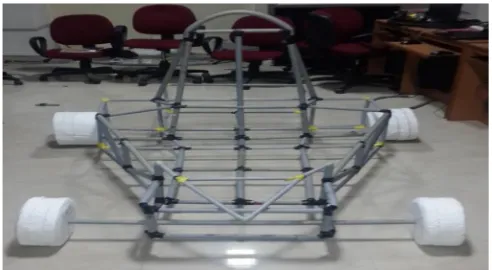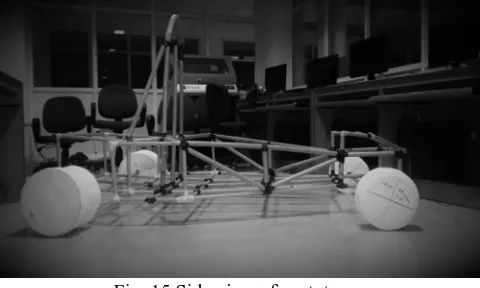Technology (IJRASET)
Design and Analysis of Electric Go-Kart Chassis
Syed Azam Pasha Quadri1, Appam Nihar2, Md Khader Mohi Uddin3, Nadeem Khan4, Muzamil Ahmed5, Syed Nomaan Qureshi6
1
Professor and H.O.D of Mechanical Department, Lords Institute of Engineering and Technology, Hyderabad
2
Assistant Professor of Mechanical Department, Lords Institute of Engineering and Technology, Hyderabad
3456
Students of Mechanical Department, Lords Institute of Engineering and Technology, Hyderabad
Abstract : This paper aims to the design analysis of a go kart chassis. The main intention is to do modeling and static analysis of go-kart chassis. The maximum deflection is obtained by analysis. The go-kart chassis are different from chassis of ordinary cars on the road. The paper highlights the material used and structural formation of chassis. The strength of material, rigidity of structure and energy absorption characteristics of chassis is discussed. The modeling and analysis are performed using 3-D software such as SOLIDWORKS, ANSYS and HYPERMESH. The loads are applied to determine the deflection of chassis. Keywords: Go-kart, Chassis Design, Solid works, Ansys, Impact Forces, Analysis
I. INTRODUCTION
The go-kart will be built from the ground up to maximize the efficient use of space, and to ensure that the needs of the client are met. We approached our design by considering all possible alternatives for a system & modeling them in CAD software like CREO Parametric 2.0 and subjected to analysis using ANSYS 15.0 FEA software. Based on analysis result, the model was modified and retested and a final design was frozen. The design process of the vehicle is iterative and is based on various engineering and reverse engineering processes depending upon the availability, cost and other such factors. So the design process focuses on following objectives: Safety, Serviceability, Strength, ruggedness, Standardization, Cost, Driving feel and ergonomics, Aesthetics. The design objectives set out to be achieved were three simple goals applied to every component of the car: durable, light-weight, and high performance, to optimizing the design by avoiding over designing, which would also help in reducing the cost. With this we had a view of our kart.
This started our goal and we set up some parameters for our work, distributed ourselves in groups for the technical design of our vehicle.
II. CHASSIS
A. Introduction
In the case of vehicles, the term CHASSIS can be described as the frame which supports all the components of the vehicle. The wheels of the vehicle are mounted on the chassis with the help of king pin and sprockets and the other parts are also attached with bolts and welding process. The chassis should be rigid from all the Bending and Torsion stress. To ensure the safety of the driver the chassis should be designed to comply with basic safety rules and at the same time serve its purpose.
B. Goals
To ensure safety of the driver. To maintain low center of gravity.
To ensure that all the systems fit onto the chassis To design a chassis with high strength and low weight.
C. Our design specifications
Wheelbase: 1474.4mm
Track width 70%. Of the wheelbase (1032mm)
Overall length: The overall length of the vehicle is 1830mm excluding the front and rear bumpers Difference between the front track width and rear track width is less than 20%
Technology (IJRASET)
TABLE.I SPECIFICATIONS
III. MATERIAL SELECTION
Cost, availability, weight, strength & weld ability are the four key factors which determine the material selection. Proceeding from these factors, the following material was chosen as the most suitable one for the kart.
TABLE.II
MATERIAL COMPOSITION OF STAINLESS STEEL 304 SEAMLESS PIPES
Component C max Cr Fe Mn Ni P Max S Max Si Max
Weight % 0.08 18-20 66.34– 74 Max 2 8-10.5 0.045 0.03 1
A. Material Specification and process
Material selected as per the rule book
The most common material for tubular space frames retains its strength and ductility after welding.
It is inexpensive, easy to weld, and easily available. The material has good mechanical properties which suits the requirements othe kart.
SS 304 has all the mechanical properties needed to make a go-kart chassis The material will be cut as per the required dimensions and then welded
Welding TIG weldin is used to weld the chassis. Stainless steel fillets will be used for the welding process.
TABLE.III
PROPERTIES OF MATERIAL Density (kg/m3) 8000
Yield strength (MPa) 205 Ultimate strength (MPa) 505 Young modulus (MPa) 193000 Poisson’s ratio 0.29 Factor of safety 1.8
B. Bumper Material
The material used for the bumpers is carbon fiber.
Overall length (mm) 1830
Chassis skeletal weight (kg) 25
Width (mm) 1016
Height (mm) 88.24
Wall thickness (mm) 1.2
Weight distribution 40:60
Technology (IJRASET)
C. Solid Modeling
After carefully reading and understanding the design parameters, the basic design of the chassis was decided. After incorporating steering mounting points and engine mounting considerations, the team has carried out several iterations to decide support members and compliance of the same has been verified and the chassis has been finalized.
IV. 3D MODELLING AND ANALYSIS
Fig.1 Top view of chassis
Fig.2 Top view with dimensions
Technology (IJRASET)
Fig.4 Side view
Fig.5 Rear view
A. Analysis
Structure, after designing must be validated to know its reliability. Conventionally in FEA, the frame is subdivided into elements. Nodes are placed where tubes of frame join. The assumption made in using beam elements is that the welded tubes have stiffness in bending and torsion, thus a higher factor of safety is desirable
Frontal Impact Frontal impact has been done by considering the kart going at its maximum possible top speed of 70kmph and undergoing a head collision with a rigid body.
B. Calculations
Mass of the kart including driver, m=250kgs =2452.5N Maximum velocity, v= 76kmph
T=0.1s time taken from top speed to stop F= mv/t = 2452.5x21.11/0.1=517722.75N
Technology (IJRASET)
Fig.7 Stresses during Frontal Impact
TABLE.IV
RESULT OF FRONT ANALYSIS
Load applied (N) 4800
Maximum deformation (m) 0.0003866
Maximum stress (MPa) 142.56
Factor of safety 3
Rear Impact The rear impact analysis has been done by considering the kart getting hit by another vehicle at its top speed. The force calculations are same as that of front impact.
Fig.8 Deformation during rear impact
Technology (IJRASET)
TABLE.V
RESULT OF REAR ANALYSIS
Load applied (N) 4800
Maximum deformation (m) 0.00110
Maximum stress (MPa) 268.36
Factor of Safety 3.7
C. Torsion
In order to calculate the torsional rigidity of the chassis during cornering, a moment due to the lateral weight transfer was considered
Fig.10 Deformation on right side during torsion
Fig.11 Stress on right side during torsion
Technology (IJRASET)
[image:8.612.175.438.270.529.2]Fig.13 Stress on left side during torsion
TABLE.VI
RESULT OF LEFT & RIGHT SIDE ANALYSIS
Parameters Left Side Right Side
Load applied N 3600 3600
Max. Stress right side (tension & compression) (MPa)
91.186 102.97
Maximum displacement right side (m)
0.00075866 0.000755
Factor of safety 2.8 3
D. Prototype
This prototype was made to better understand the design of the chassis
[image:8.612.184.430.566.701.2]Technology (IJRASET)
Fig. 15 Side view of prototype
V. CONCLUSIONS
The designing of chassis for go-kart can develop many skills. The learning of 3-D modeling software like Solid works is essential to obtain desire design. The analysis of design determines the stresses developed in the chassis which plays an important role in factor safety. From the analysis we can predict the chassis is safe or not and also by seeing the deformation and stresses modification in the kart chassis is possible.
VI. ACKNOWLEDGEMENT
The authors working on the design and analysis of an electric go-kart chassis would like to thank all those who have sincerely and whole heartedly lend their support and contributed to the project. We express our gratitude and thankfulness to the professors for their valuable guidance and their co-operation in the project.
We are also very much thankful to Head of the Department, Mechanical Engineering and project guide for their inspiring guidance with helpful suggestions for the project. We are greatly obliged to the entire staff of the Department of Mechanical Engineering, Lords Institute of Engineering and Technology, Hyderabad
REFERENCES
[1] Automobile Engineering - Kirpal Singh.
[2] Shaik Himam Saheb, Govardhana Reddy, Md. Hameed, Design report of a go kart vehicle, International Journal of Engineering Applied Sciences and Technology, Vol. 1, Issue 9, ISSN No. 2455-2143.
[3] Aritra Nath, C.Jagadeesh Vikram, Lalchhanchhuah, Lalrinsanga , Lamphrang Nongrum & Philic Marboh, Design and fabrication of a Go-kart, International Journal of Innovative Research in Science, Engineering and Technology, Vol. 4, Issue 9, ISSN: 2319-8753, September 2015.
[4] Ravindra Laxman Gaikwad, Prathmesh Vishwas Waghmare, Lalit Daulatrao Deore, Akshay Mukesh Mutake, Design of Go-kart vehicle system, International Journal of Advanced Technology in Engineering and Sciences, Vol.No.4., Issue No.03,ISSN 2348-7550, March 2016.
[5] Koustubh Hajare, Yuvraj Shet, Ankush Khot, A Review Paper on Design and Analysis of a Go-Kart Chassis, International Journal of Engineering Technology, Management and Applied Sciences, Volume 4, Issue 2, ISSN 2349-4476, February 2016.
[6] Anjul Chauhan, Lalit Naagar, Sparsh Chawla, Design And Analysis Of A Go-Kart, International Journal of Aerospace and Mechanical Engineering, Volume 3 – No.5, ISSN (O): 2393-8609, September 2016.
[7] Abhinay Nilawar, Harmeet singh Nannade, Amey Pohankar, Nikhil Selokar,Design of Go kart, International Journal for engineering Applications and Technology, ISSN: 2321-8134.
[8] D.Raghunandan, A.Pandiyan, Shajin Majeed, Design and Analysis of Go-Kart Chassis, international journal of engineering sciences & research technology, volume: 3.00, ISSN: 2277-9655, November 2016.
[9] Kiral Lal, Abhishek O S, Design, Analysis And Fabrication Of Go-Kart, International Journal of Scientific & Engineering Research, Volume 7, Issue 4, ISSN 2229-5518, April-2016

